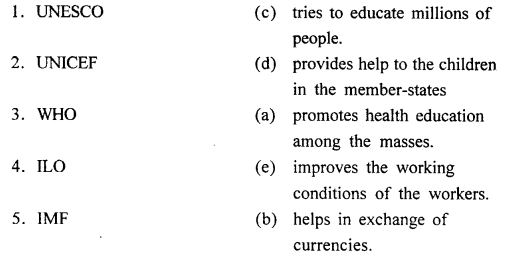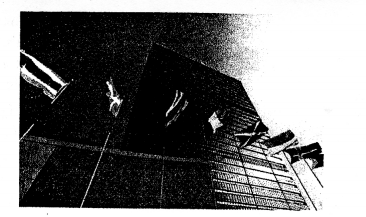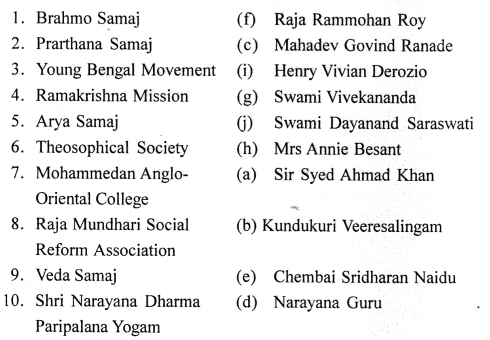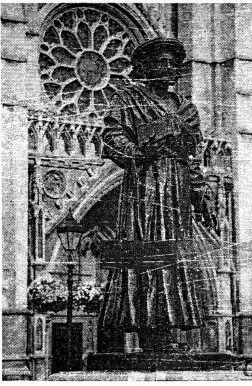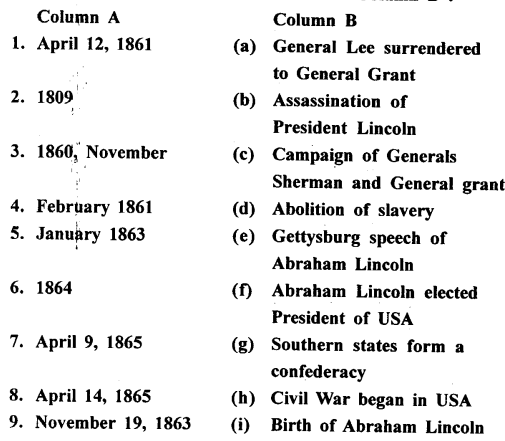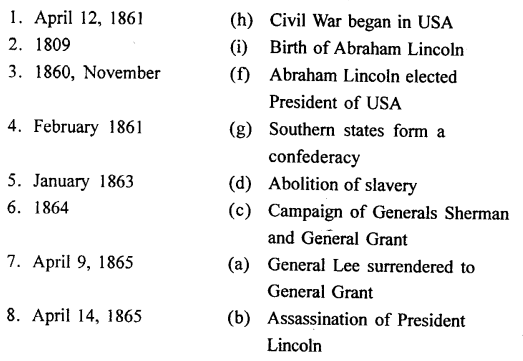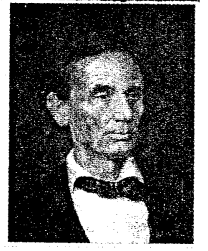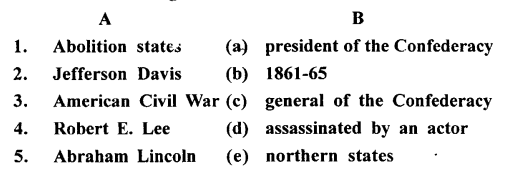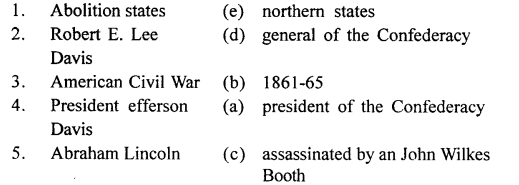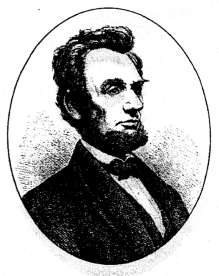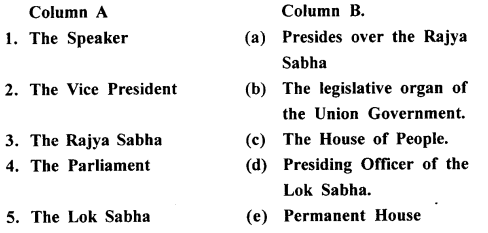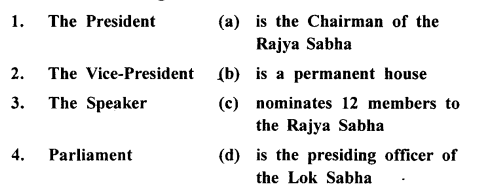ICSE Solutions for Class 8 History and Civics – Struggle for Freedom (I)
ICSE SolutionsSelina ICSE SolutionsML Aggarwal Solutions
APlusTopper.com provides step by step solutions for ICSE Solutions for Class 8 History and Civics. You can download the History and Civics ICSE Solutions for Class 8 with Free PDF download option. History and Civics for Class 8 ICSE Solutions all questions are solved and explained by expert teachers as per ICSE board guidelines.
ICSE Solutions Class 8 History & Civics GeographyBiologyChemistryPhysicsMaths
Time To Learn
I. Fill in the blanks:
- The British shattered the self sufficient village economy.
- The controversial Ilbert Bill incident took place in 1883.
- The Arms Act forbade the Indians from possessing arms.
- The President of the first session of the Congress was W.C. Bannerji.
- Bal Gangadhar Tilak raised the slogan “Swaraj is my birthright”.
- The three prominent leaders of the Radical Nationalists group were Lala Lajpat Rai, Bal Gangadhar Tilak, and Bipin Chandra Pal.
- Mahatma Gandhi was bom on 2nd October 1869 at Porbandar.
- Gandhiji’s method of agitation were Satyagraha, boycott and strikes.
- The incident at Chauri Chaura took place on 5th February 1922.
II. Match the contents of Column A with those of Column B:

Answer:

III. State whether the following statements are true or false:
- The Congress was started in 1885.
True. - Unification of India as one political unit was achieved by the Indians themselves.
False. - The British treated the Indians at par with themselves.
False - A prominent leader of the Early Nationalist groups was S.N. Bannerjee.
True. - The religious and social reform ^movement divided the Indians.
False. - The Home Rule League was formed under the leadership of Tilak.
True. - Chauri Chaura is a place in Madhya Pradesh.
False. - Rowlatt Act was passed in 1923.
False.
IV. Answer the following questions:
Question 1.
How did unification of India help to bring about a feeling of nationalism among the Indians?
Answer:
Political and administrative unification of India helped in the rise of nationalism. Under the British rule India was united as one political unit. The uniformity in laws and administration gave rise to a feeling of oneness among the people.
Question 2.
How did modern education bring about unity among Indians?
Answer:
Indians who received modem education could now read western thought and literature. They were exposed to the revolutionary changes taking place in the west – the American and French Revolutions. They became aware of the ideas of democracy, equality and nationalism. The reform movement also played an important role. All this brought the people together and created unity among them.
Question 3.
Name two early all-India associations.
Answer:
- British Indian Association, 1851.
- The Bombay Association, 1852.
Question 4.
Why was the need for establishing an all-India organisation, representing Indian opinion, an urgent necessity?
Answer:
The need for an all India Organisation representing Indian opinion had been felt for a long time, but the immediate reasons which saw its birth, were the repressive policies of the British in the 1870s and the 1880s. In 1883 the controversial Ilbert Bill incident took place. According to it a British or a European in India could be tried by an Indian Judge. The Bill was withdrawn because of the opposition by the British.These events made the need for establishing an all-India organisation, representing Indian opinion an urgent necessity.
Question 5.
Differentiate between the methods of Early Nationalists and Radical Nationalists.
Answer:
The Early Nationalists had faith in the British system of administration and believed that India could develop by staying within the British Empire. They did not demand complete independence but dominion status i.e., autonomy or Swaraj within the British empire. 1905 onwards new trends began to appear in the nationalist movement. Bal Gangadhar Tilak, Lala Lajpat .Rai and Bipin Chandra Pal were the leaders who brought about this change. They said the aim of Indians should be ‘Swaraj’. They criticised the policies of the Early Nationalists and said people have to rely on their strength rather than “Prayer and Petition”. Tilak raised the famous slogan “Swaraj is my birthright and I must have it”.
The methods they suggested to achieve it were:
- Involvement and participation of the masses
- Reviving popular Festivals to spread Political awakening among people.
- New methods of agitation such as hartals and boycott of foreign goods and services.
Question 6.
Which factors contributed to the building up of the feeling of nationalism in India?
Answer:
There are several factors responsible to the building up of the feeling of nationalism in India.
They are :
- Discontentment against British Rule.
- Political and Administrative Unification.
- Economic changes.
- Spread of modem education.
- Role of newspapers and the press.
Question 7.
List down the aims of the Muslim League.
Answer:
Aims of Muslim League:
- To promote loyalty to the government
- To protect and advance the interest of the muslims
- To ensure that Muslims do not develop the feelings of hostility towards other communities in India.
Question 8.
Describe the provisions of the Government of India Act (1919).
Answer:
The Provincial Legislative Councils were enlarged and a majority of their members were to be elected. A new system called Dyarchy was introduced in the provinces. Under this system some subjects, such as finance, law and order were called reserved subjects and remained under the direct control of the Governor. Other subjects such as education, public -health, local self government were called ‘transferred’ subjects and were to be controlled by ministers responsible to the provincial legislature,
Question 9.
Describe the constructive programme introduced by Gandiji.
Answer:
The social reforms and the constructive programmes introduced by Gandhiji changed the character of the national movement to a mass movement. He worked towards removing untouchability. He also worked for the upliftment of the people living in the villages. He said that the majority of India’s population lived in the villages and hence our country could progress only if there was development in the villages. He encouraged setting up small scale industries in villages. He also popularised Khadi. The Charkha became an important symbol. Gandiji believed that Independence was meaningless without social and economic equality.
V. Picture Study:
(A) This picture shows three Radical Nationalist leaders.
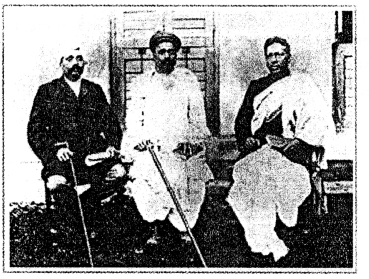
- Identify and name them.
Ans. They are Lala Lajpat Rai, Bal Gangadhar Tilak and Bipin Chandra Pal. - Write about the methods which they suggested.
Ans. They suggested idea of boycott and Swadeshi. They insisted on involvement of the masses. - What was the famous slogan raised by Bal Gangadhar Tilak?
Ans. “Swaraj is my birthright and I must have it.”
(B) Look at the given picture.

- Identify and name him
Ans. Lord Curzon - When did the partition of Bengal take place
Ans. 1905 - What was the real reason behind the partition.
Ans. To weaken the freedom movement and to create Hindu-Muslim enmity and disunity. - What excuse did the British give?
Ans. Bengal was too large a province to be governed efficiently.
Additional Questions
Rise of Indian Nationalism
EXERCISES
A. Fill in the blanks:
- Modem Indian nationalism arose to meet the challenge of Foreign domination.
- Exploitation of India by the British was direct and harsh before 1857; after 1857 it became subtle and systematic.
- The Kukas Rebellion was an armed rebellion of the Sikhs against the British policy of divide and rule.
- The English language acted as a link language among the educated Indians.
- A.O. Hume laid the foundation of the Indian National Congress in December 1885.
B. Match the following:

Answer:

C. Choose the correct answer:
1. ‘Vande Mataram’ was written by Swami Vivekananda/Raja Ram Mohan Roy/Bankim Chander Chattopadhyaya.
Ans. ‘Vande Mataram’ was written by Bankim Chander Chattopadhyaya.
2. Lord Ripon/Lord Lytton/Lord Dalhousie approved the Hbert Bill.
Ans. Lord Ripon approved the Ilbert Bill.
3.The Indian National Congress was established in 1883/1885/ 1890.
Ans. The Indian National Congress was established in 1885.
4.The first session of the Indian National Congress was attended by 62/72/82
Ans. The first session of the Indian National Congress was attended by 72 delegates.
5. The first session of the Indian National Congress was presided over by C. Bannerjee/Surendranath Banerjea/A.O. Hume.
Ans. The first session of the Indian National Congress was presided over by W.C. Bannerjee|
D. State whether the following are true or false:
- The Revolt of 1857 had failed to rid India of foreign rule.
True. - Western education and modern ideas could not bring the Indians togethe
False.
Correct : Western education and modem ideas bring the Indians together. - Racial arrogance and racial discrimination by the British caused great resentment among Indian intellectuals.
True. - The Ilbert Bill had to be amended as the European reacted violently to it.
True. - O. Hume was not supported by nationalist Indian leaders.
False.
Correct: A. O. Hume was supported by nationalist Indian leaders.
E. Answer the following questions in one or two words/ sentences:
Question 1.
Define nationalism.
Answer:
Nationalism may be defined as a devotion and loyalty to one’s own nation, patriotism. It is also the policy or doctrine of asserting the interest of one’s own nation vie .ved as separate from the interests of others nations or common interest of all nation.
Question 2.
Name any two Western scholars who researched the Indian past and rediscovered its rich heritage.
Answer:
European scholars like William Jones, Alexander Cunningham, James Prinsep and other Indologists, who researched India’s historical past and revealed its rich heritage.
Question 3.
How did the British economic policies in India transform India into an agricultural colony.
Answer:
British economic policies in India had deliberately transformed India into an agricultural colony. India had become a supplier of British raw materials and a market for British manufactured products.
Question 4.
Why was the Ilbert Bill introduced and by whom?
Answer:
Lord Ripon, who followed Lord Lytton, wanted to change some of the discriminatory policies of the government. He approved the Ilbert Bill which proposed that Indian judges be allowed to try Europeans (whites) accused of crimes.
Question 5.
When and where was the first session of the Indian National Congress held?
Answer:
The first session of the Congress was held in Bombay (now Mumbai) in December 1885.
F. Answer the following questions briefly:
Question 1.
There were many factors that led to the rise of nationalism in India. In the light of this statement, answer the following questions:
(a) In what way did the Revolt of 1857 impact the rise of nationalism in India?
(b) What changes did Western education bring about in the traditional Indian outlook?
(c)The English language acted as a link language among the Indians. Explain.
Answer:
(a)
Exploitation after Revolt of 1857, was subtle and systematic.
The impact of exploitation was felt by almost all sections of Indian society, but it took several decades to comprehend the true nature of British rule and establish the link between British polices and India’s growing poverty. Several armed revolts took place after 1857. The Kuka rebellion was one such revolt. It was a protest against the deliberate policy of the British to create a rift between the Hindus and the Muslims.
(b)
The British had introduced Western Education in India to create a class of loyal clerks and Anglicized buyers of British goods. Western education did that and much more. It opened the floodgates of modem knowledge and rational thinking. New ideas of humanism, nationalism and democracy transformed the traditional outlook of the people. A new class arose-English-educated Indians-small in number but who in course of time, would produce, leaders and organizers of a national movement.
(c)
The English language acted as a link language between the educated Indians and various parts of the country. Thus, it played a very significant role in fostering feelings of unity among educated Indians from different provinces and linguistic regions of the country. The barriers of language now broke down as the English language became the common medium of communication. Educated middle class Indians who spoke different language could now express their views and exchange ideas among themselves in English. A common language fostered a sense of oneness and understanding of their Indian identity.
Question 2.
In the context of the causes of the rise of Indian nationalism,answer the following questions:
(a) How did the British administrative system indirectly create conditions favourable for the growth of Indian nationalism.
(b) Examine the role of modern transport and communication in fostering unity and nationalism among the people.
(c)How did the rediscovery of India’s glorious past prepare the ground for the growth of the national spirit among the Indians.
Answer:
(a)
The British transformed a fragmented India into a united whole under their rule. They introduced a uniform and modern system of government throughout the British provinces. Uniform laws were applied to all British subjects. People from different provinces and from different communities and castes now followed the same laws and regulations. They gradually realized that they all belonged to the same country and shared a common national identity as Indians.
(b)
This growing sense of unity and nationalism was further strengthened when the British introduced a new network of roads, railways and the post and telegraph system. Social mobility and interaction increased. Caste barriers broke down. People from different parts of the country grew closer to each other. They realized that they shared common problems, common aspirations and common goals. They belonged to one nation.
(c)
The rediscovery of a past was great and glorious. It was a past that could boast of the intellectual richness of Vedic philosophy, the political unity and administrative wisdom of the Mauryas, the Golden Age of the Guptas and the cultural brilliance of the Mughals. These discoveries were made by European scholars like William Jones, Alexander Cunningham, James Princep and other Indologists, who researched India’s historical past and revealed its rich heritage. These revelations instilled in the Indians feelings of national pride and self-confidence and inspired them to dream of a new resurgent India.
Question 3.
With reference to the rise of Indian nationalism, answer the following questions:
(a) What was the role of vernacular press and literature in the rise of Indian nationalism?
(b) How did the British economic policies lead to the growth of Indian nationalism?
(c) Mention the discriminatory British policies that were greatly resented by the Indian intellectuals.
Answer:
(a)
The vernacular press played a vital role in spreading modern ideas and creating national awareness. Nationalist leaders, the best among the educated middle-class intellectuals, used the press to criticize British policies and expose the evils of foreign rule. The ideas of democracy and responsible government were popularized through the press. Indians were asked to unite and work for the welfare of the nation. National literature also inspired the spirit of nationalism among the people. Novels, essays and patriotic poems written by well-known authors and poets fired the imagination of the common people and gave rise to powerful patriotic feelings. Bankim Chandra Chattopadhyaya’s ‘Vande Mataram’ continues to evoke strong patriotic emotions among Indians even to this day.
(b)
The drain of India’s wealth to Britain, the impoverishment of the masses, industrial decay, grinding poverty, frequent famines, and the indifference and apathy of the British government produced a nationalistic reaction. The educated Indians realized the gravity of the situation and the need to have some control over economic policies.
(c)
Discriminatory policies adopted by the British:
- Indians were debarred from using parks, clubs, hospitals, libraries and railway coaches reserved exclusively for the British.
- All important positions in the administration were also reserved for the British. (Surendranath Banerjee was dismissed from the Indian Civil Service on flimsy grounds) Nominated Indian members in the Legislative Councils were not given any powers.
- British economic policies sacrificed Indian interests to those of the British. Lord Lytton’s discriminatory policies caused great resentment among the educated Indians.
Question 4.
In the context of the Indian National Congress, answer the following questions:
(a) Briefly discuss the Ilbert Bill controversy and show how it hastened the establishment of the Indian National Congress.
(b) What role did A. O. Hume play in the establishment of the Indian National Congress?
(c) Mention the main aims of the Congress.
Answer:
(a)
Lord Ripon, who followed Lord Lytton, wanted to change some of the discriminatory policies of the government. He approved the Ilbert Bill which allowed Indian judges to try Europeans (whites) accused of crimes. The violent reaction of the Europeans and Anglo-Indians to this proposal shocked the Indian nationalists. The Bill had to be amended. This incident blew the lid off the racial arrogance of the Europeans. It served as an eye-opener and drove home the urgent need to form an organized national bod to protect the interest and dignity of the Indians. In 1883, Surendranath Banerjee held the Indian National Conference, and within 2 years, the Indian National Congress was formed.
(b)
O. Hume was one of the founders of the Indian National Congress, a political party that was later lead to Indian Independence Movement. Hume took the initiative and it was in March 1885, when the first notice was issued convening the First Indian National union to meet at Poona in December. Founded in 1885 with the objective of obtaining a greater share in government for educated Indians, Indian National Congress was initially not opposed to British rule. The Congress met once a year during December. A. O. Hume is known for prominent figure of Indian Independence Movement activisim and reorganizing and leading the Indian National Army in World War II.
(c)
The main aims of the Congress were:
- To promote friendly relations among nationalist workers in different parts of the country.
- To develop and strengthen feelings of national unity throughout the country.
- To formulate popular demands and to place them before the government.
- To train and organize public opinion in the country
G Picture study:
This is a picture of a person who was dismissed from the Indian Civil Service by the British on flimsy grounds

- Identify the person in the picture
Ans. Surendranath Banerjee - Name the conference that he held in 1883.
Ans. Indian National Conference - What was the outcome of the conference?
Ans. Indian National Congress was established in 1885, as a result of the conference in 1883. - What were the main aims of the Indian National Congress?
Ans. Refer Ans. F-4 (c) above.
Additional Questions
The Indian National Movement (1885-1916)
EXERCISES
A. Fill in the blanks:
- The early nationalists spread political awareness among the people.
- The assertive nationalists believed that British rule in India was not a blessing but a curse.
- After the partition of Bengal, the assertive nationalists adopted the methods of boycott, swadeshi and national education to achieve the goal of swaraj.
- Separate electorates meant that the Muslim voters could elect Muslim representatives.
- Gandhi spent about 22 years in South Africa as a practising lawyer.
B. Match the following:

![]()
Answer:

C. Choose the correct answer:
- The history of the Indian national movement is broadly categorized into three/four/five
Ans. The history of the Indian national movement is broadly categorized into three phases. - Bal Gangadhar Tilak/Dadabhai Naoroji/Surendranath Banerjea was an important assertive nationalist leader.
Ans. Bal Gangadhar Tilak was an important assertive nationalist leader. - The British followed the policy of divide and rule by dividing Bengal/Punjab/Gujarat on communal lines.
Ans. The British followed the policy of divide and rule by dividing Bengal on communal lines. - The Muslim League was established in 1905/1906/1913.
Ans. The Muslim League was established in 1906. - Gandhiji studied law’ in England/South Africa/France.
Ans. Gandhiji studied law in England.
D. State whether the following are true or false:
- The early nationalists believed in the sense of justice and fair play of the British.
True. - The early nationalists presented their grievances to the British in the form of protests and strikes.
False.
Correct: The early nationalists presented their grievances to the British in the form of meetings, lectures and the press. - The political beliefs, aims and methods of the assertive nationalists were the same as those of the early nationalists.
False.
Correct: The political beliefs, aims and methods of the assertive nationalists were different as those of the early nationalists. - The assertive nationalists had no faith in the constitutional methods followed by the early nationalists.
True. - Tilak knew that the British would concede to the demand of swaraj easily without any struggle.
False.
Correct : Tilak knew that the British would never concede to the demand of Swaraj easily without any struggle.
E. Answer the following questions in one or two words/ sentences:
Question 1.
Mention two leaders of the early nationalist phase.
Answer:
The important leaders of the early nationalist phase were Dadabhai Naoroji, Surendranath Banerjea and Gopal Krishna Gokhale.
Question 2.
Mention two leaders of the assertive nationalist phase.
Answer:
The important leaders of the assertive nationalist phase were Bal Gangadhar Tilak, Bipin Chandra Pal, Lala Lajpat Rai and Aurobindo Ghosh.
Question 3.
Why were the assertive nationalists disillusioned with the leadership of the early nationalists?
Answer:
The assertive nationalists had no faith in the constitutional methods followed by the early nationalists. They knew that the British would never concede to the demand for swaraj without a struggle. So they have to adopt a method of active opposition to government Swaraj would have to be achieved through a political, anti-government agitation and with the involvement and support of the masses. The Congress would have to be transformed from a platform for debates among the westernized, Indian intelligentsia into a regiment of freedom fighters-united, determined, confident and willing to make sacrifices.
Question 4.
When and why was Bengal partitioned?
Answer:
The British partitioned Bengal in 1905 in pursuance of their policy of divide and rule.
Question 5.
Where and under whose leadership was the Muslim League established?
Answer:
The Muslim League was established in December 1906, under the leadership of Nawab Salimullah Khan in Dacca (now known as Dhaka).
Question 6.
Mention two objectives of the Muslim League?
Answer:
Objectives of Muslim league:
To promote among the Muslims a feeling of loyalty towards the British government.
- To protect and promote the political rights of the Muslims.
- To prevent feelings of hostility towards other communities.
Question 7.
Why was the introduction of separate electorates a death blow to national unity?
Answer:
Separate electorates refers to the voting population of the country, divided into different electorates based on the factors like religion, caste, occupation etc. For example, it meant that Muslim voters could elect Muslim representatives. The introduction of separate electorates sounded the death knell of national unity. It was the first definite step on the road to the partition of India.
Question 8.
Why did the Indian nationalists support the war effort of the British when the First World War broke out ?
Answer:
Initially, there was an outburst of loyalty and the Indian nationalist leaders supported the British government with men and money. More than a million Indian soldiers were sent overseas to join the British army and a hundred million pounds were given to the British government.
The British and their allies declared that they were fighting the war to make the world ‘safe for democracy’ and to promote the right of all nations to form self-governments. This led the Indian nationalists to believe that a grateful Britain would reward India’s loyalty and fulfil its demands for self-government.
Question 9.
What was the main aim of the Home Rule Leagues ?
Answer:
The main aim of the Leagues was to achieve self-government within the British empire after the war.
F. Answer the following questions briefly:
Question 1.
With reference to the early nationalists, discuss the following:
(a) Beliefs of the early nationalists
(b) Methods of the early nationalists
(c) Important contributions made by the early nationalists to the national movement?
Answer:
(a)
The early nationalists believed that British rule had conferred several benefits on India. They felt that at that stage of history it was in their own interests to remain under the British since they were not yet ready to govern themselves. The early nationalists were convinced that the British could be persuaded to introduce necessary reforms and the government could be transformed to suit the interests of the Indian subjects.
(b)
The early nationalists had great faith in the sense of justice and fair play of the British. So they adopted peaceful and constitutional methods. They presented their grievances to the government and waited patiently for the government to pass laws to remove those grievances. They believed that the government would gradually give into their demands. They promoted unity, spread political awareness among the people and built up a strong public opinion through meetings, lectures and the press. They also sent delegations to England to persuade the British government to introduce necessary reforms.
(c)
Contribution of the early nationalists:
- The early nationalists established a solid foundation which served as a base for a more radical approach in later years.
- They spread political awareness among the people and instilled in them a sense of national unity. The people began to think of themselves as a members of one single nation the Indian nation. The path for a united national struggle was laid.
- The Congress under the early nationalists trained the Indians in political affairs. They educated them in political matters and familiarized them with ideas of freedom, government, democracy, secularism nationalism, etc. This knowledge and training in political affairs helped Indian nationalists to organize and raise the national movement to the next stage of development.
Question 2.
With reference to the rise of the assertive nationalists within the congress, discuss:
(a) The beliefs of the assertive nationalists
(b) The objectives of the assertive nationalists
(c) How the methods of the assertive nationalists differed from those of the early nationalists?
Answer:
(a)
The assertive nationalists had no faith in the British sense of justice and fair play. They believed that the British rule in India was not a blessing but a curse. They were convinced that the British had no honest intentions of introducing reforms for the welfare of the Indians. They realized that the British interests were different and clashed with the Indian interests. India could never grow and progress under British rule.
(b)
The goal of the assertive nationalists was not selfgovernment in ‘gradual’ stages but immediate freedom (Swaraj) from British rule.
(c)
The early nationalists had great faith in the sense of justice and fair play of the British. So they adopted peaceful and constitutional methods. They presented their grievances to the government and waited patiently for the government to pass laws to remove those grievances. They believed that the government would gradually give in to their demands. They promoted unity, spread political awareness among the people and built up a strong public opinion through meetings, lectures and the press. But the assertive nationalists on the other hand, had no faith in the constitutional methods followed by the early nationalists. Twenty years of prayers, petitions, appeals and resolutions and representations had failed to yield any concrete results.
Question 3.
With reference to the Lucknow Session of the Congress of 1916, answer the following questions:
(a) What was the Lucknow Pact ?
Ans. The Lucknow Pact was an agreement signed by the Muslim League and the Congress to pave the way for a joint scheme of political reforms in India.
(b) What was the objective of the Lucknow Pact
Ans. Under the Lucknow Pact, the League jointly with the Congress put forward the demand for a Dominion Status for India. This was an important step towards Hindu-Muslim unity.
(C) What were the results of Lucknow Pact ?
Ans. The unity between the Muslim League and the Congress, on the one hand and the early nationalists and the assertive nationalists, on the other, aroused great political enthusiasm and strengthened the national movement.
G Picture study:
This is the picture of a national leader.
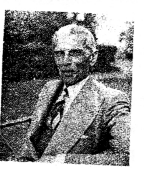
1.Identify the person in the picture.
Ans. Muhammad Ali Jinnah.
2.Which political organization did he join and when ?
Ans. Muhammad Ali Jinnah joined the Muslim League in 1913.
3.When and by whom was this organization founded ?
Ans. The Muslim League was established in December 1906, under the leadership of Nawab Salimullah Khan in Dacca (now known as Dhaka).
4.What were the objectives of this organization ?
Ans.
The main objectives of the Muslim League were as follows:
- To promote among the Muslims a feeling of loyalty towards the British government.
- To protect and promote the political rights of the Muslims.
- To prevent feelings of hostility towards other communities.


